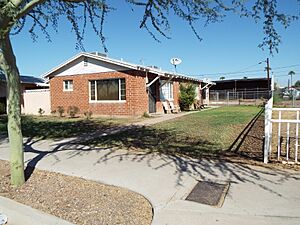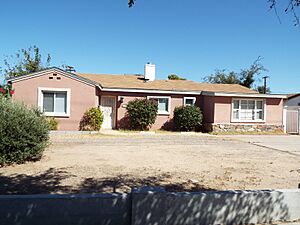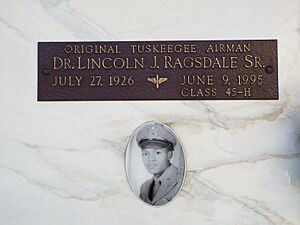Lincoln Ragsdale facts for kids
Quick facts for kids
Lincoln Ragsdale
|
|
|---|---|
 |
|
| Born | July 27, 1926 |
| Died | June 9, 1995 (aged 68) |
| Occupation | Tuskegee Airman, community organizer |
| Known for | Civil Rights Movement |
| Spouse(s) | Eleanor Ragsdale |
Lincoln Johnson Ragsdale Sr. (born July 27, 1926 – died June 9, 1995) was a very important leader in the Phoenix area's Civil Rights Movement. He was known for speaking up. Ragsdale helped a lot with many changes in the Valley. These changes included getting voting rights for everyone. He also worked to end segregation in schools, neighborhoods, and public places.
Contents
Early Life and Family Values
Lincoln Ragsdale was born on July 27, 1926. His parents were Hartwell Ragsdale and Onlia Violet Ragsdale. They lived in Tulsa, Oklahoma. His father was a mortician, and his mother was a schoolteacher.
In 1921, his father's business was in the Greenwood neighborhood of Tulsa. This area was attacked during the terrible Tulsa race riot. A mob burned down many Black-owned businesses, including his father's. Lincoln grew up hearing about this event.
His mother, Onlia, was the first in her family to go to college. She led the Oklahoma chapter of the National Association of Colored Women's Clubs. Lincoln's parents taught him how important education was. He went to the segregated Douglass High School. Around this time, he started loving to fly. He also began earning money to pay a pilot for regular flights.
Becoming a Tuskegee Airman
After high school in 1944, Lincoln Ragsdale joined the Tuskegee Airmen. This was a group of brave Black military pilots during World War II. He was interested in flying and in fighting for racial equality. He said he joined to show that Black people could fly planes successfully.
He trained in Alabama in 1945. There, he faced serious racial discrimination. He was later sent to Luke Air Force Base in Arizona for gunnery training. He was one of the first Black soldiers to help integrate that base. Ragsdale was surprised to find that Phoenix also had a lot of racism. In November 1945, he became a second lieutenant.
Starting Businesses in Phoenix
After the war, Lincoln Ragsdale moved to Phoenix in 1946. He and his brother Hartwell started a mortuary business. This was a family tradition. At first, no banks would give him a loan because he was Black. But a stranger lent him $35,000. This allowed him to open Phoenix's first Black-owned funeral home in 1948.
He later earned degrees from Arizona State University and Union Graduate School. In 1949, he married Eleanor Ragsdale. She was a local schoolteacher and became an important activist too.
Ragsdale owned many businesses over the years. These included real estate, construction, a restaurant, insurance companies, and a flower shop. He became wealthy while also fighting for civil rights. He used his businesses to challenge unfair practices. Since Black and Hispanic people couldn't go to white-owned businesses, he served them. His business grew quickly within the Black community.
Later, in the 1960s, Ragsdale started serving white and Hispanic customers too. He even hired white workers. He changed his business name to "Universal Memorial Center." He saw this as part of his fight for integration. He believed in working together, not just in separate Black-only situations.
Fighting for Civil Rights
Early Efforts for Equality
The Ragsdales helped start the Greater Phoenix Council for Civic Unity (GPCCU) in the late 1940s. One of Ragsdale's first civil rights actions involved a Black soldier named Pfc. Thomas Reed. In 1952, Reed was killed in the Korean War. His family wanted him buried in the military veterans' plot in Phoenix. But the cemetery was segregated, and that plot was only for white soldiers.
Ragsdale worked with the GPCCU to share this story in the news. After three months, the cemetery finally agreed to integrate. Ragsdale then worked to integrate other cemeteries too.
In 1951, Ragsdale joined the GPCCU board. He and the GPCCU pushed for a law to desegregate Arizona's schools. The law passed, but it only let schools choose to desegregate. Phoenix schools did not choose to. So, the GPCCU tried to get a local vote to desegregate Phoenix schools, but it failed.
In 1952, the Ragsdales, GPCCU, and NAACP supported a lawsuit. It was against the white-only Phoenix Union High School. The lawsuit challenged the law that allowed segregation. A judge ruled that school segregation laws were illegal. This happened over a year before the famous Brown v. Board of Education decision by the Supreme Court.
Breaking Housing Barriers
In 1953, the Ragsdales made history. They moved into a home in the fancy Encanto area of Phoenix. This area was north of the "red line." This line separated white and Black neighborhoods. Black people were usually not allowed to buy homes north of Van Buren Street. Banks would not give them loans, and real estate agents would not show them houses.
Eleanor Ragsdale was a real estate agent. She was also light-skinned enough to be mistaken for white. This helped her find a suitable home in a white neighborhood. The Ragsdales could not buy the house themselves. So, they asked a white friend to buy it and then transfer the ownership to them.
Their neighbors threatened them. Local police stopped them often while they drove in their own neighborhood. They even found racial slurs written on their home. Despite this, they lived in the home for 17 years. They raised their four children there. They became a symbol of fighting housing discrimination. Other Black families used their method to move into white areas. Eleanor often helped them.
NAACP and Public Places
By the 1960s, Ragsdale and Rev. George B. Brooks were leaders in the Maricopa County NAACP. They organized protests. They also met with business leaders to end job discrimination against Black people. Ragsdale also started targeting segregation in public places. In 1962, he and Eleanor organized protests at Phoenix Woolworth's stores. This was similar to the 1960 Greensboro sit-ins.
Ragsdale ran for Phoenix City Council in 1963. His campaign brought attention to the lack of minority leaders in government. It also helped many new African-American and Latino voters register. In 1964, Ragsdale successfully pushed the Phoenix City Council to pass a public accommodations law. A year later, Arizona passed a statewide civil rights law. These laws were like the federal Civil Rights Act of 1964. In 1964, Martin Luther King Jr. also gave a speech at Arizona State University at Ragsdale's invitation. The Ragsdales then hosted him at their home.
Working with the Hispanic Community
In Phoenix, the Black population was small in the 1950s and 1960s. Hispanic people outnumbered Black people by a lot. This meant that civil rights efforts in Phoenix needed more cooperation between different groups. This was different from other parts of the Civil Rights Movement.
Later Life and Legacy
As a pilot, Ragsdale served on the Phoenix Municipal Aeronautics Advisory Board in the 1970s. Later, Ragsdale was very involved in the fight to create a statewide Martin Luther King Jr. Day in Arizona. This holiday finally passed in 1992 after people voted for it.
Lincoln Ragsdale died on June 9, 1995, from colon cancer. He passed away at his home in Paradise Valley, Arizona. His crypt is in the Serenity Mausoleum in Phoenix.
The executive terminal at Phoenix's Sky Harbor International Airport was renamed the Lincoln J. Ragsdale Executive Terminal to honor him. The Links, Incorporated Phoenix Chapter, where the Ragsdales were active, contributes to the Arizona State University Dr. Lincoln J. Ragsdale Memorial Scholarship. This scholarship is also named in his honor.




